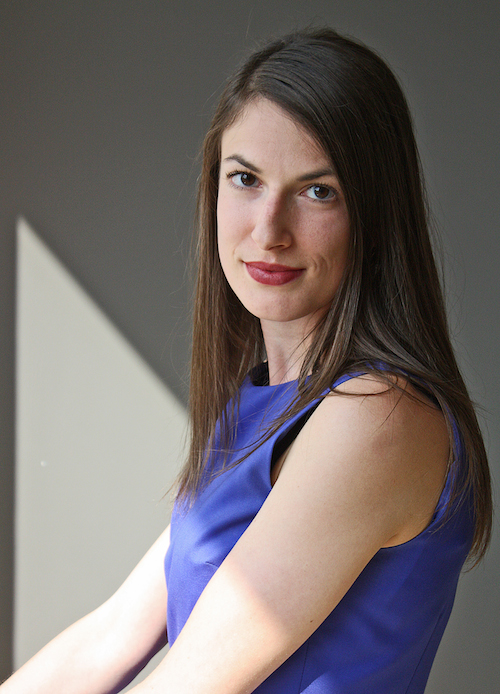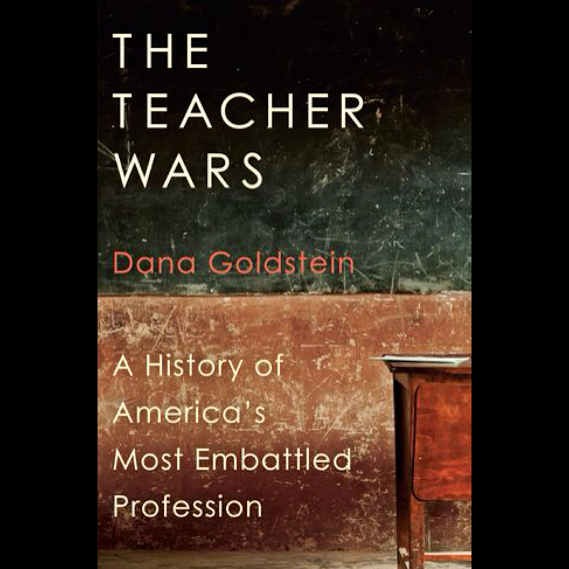An interview with Dana Goldstein about the roller coaster ride that is public education in our country and the release of her first book, The Teacher Wars.
by Kaylen Ralph
Dana Goldstein has covered public education since 2007 for publications such as Slate, The Atlantic, and The Nation. Her area of interest is not surprising; both Goldstein’s father and grandfather are longtime public school educators, and Goldstein got her real start in journalism while working for The American Prospect, where she developed a passion for covering big-picture public policy.
I had some questions for Goldstein about her book and her perspective on the current state of public education in the United States. As she points out in our interview, journalism and education are similar, in that they are both “service professions aimed at creating a more knowledgeable public.”

In Teacher Wars, your book (released by Doubleday on 9/4), you point out that “people choose careers based less on the raw salary than on the perceived gap between what they could make in one job versus another.” If an ideal teacher candidate foregoes a career in education for another job, what industry are they (generally) opting for?
This is an interesting question, but there is not good research on this that I am aware of, which would ask, say, college seniors if they considered teaching and then track what field they actually enter. The profession that (at least anecdotally) is often talked about as an alternative to teaching, especially for those with an interest in the humanities, is law.
What will it take for more teachers of color and more male teachers to enter the field (as you write, only 17 percent of public school teachers are nonwhite, and only 24 percent of teachers are male)?
I think better pay, particularly early in the career, would certainly help. People of color are more likely to have student loans to pay off, and there is some evidence that men are more salary-sensitive when choosing a profession than women are.
There is something more nebulous, too, which is that teaching has to be perceived as more autonomous and more intellectually rigorous. We can move in that direction, culturally, by creating policies that empower teachers as both independent thinkers and collaborative members of adult teams who are tasked with helping children think critically and grapple with big, challenging ideas. Teachers have to be part of conversations about evaluation and the curriculum, and they have to have meaningful leadership opportunities within their schools and districts.
You cover so many issues in this book, but what do you consider the most pressing and urgent issue you address? What can our country no longer afford (literally, morally and logistically) to continue stalling on finding a solution for?
I think the answer to this is related to the last question. Both historically and in the present day, we have not looked to teachers themselves for ideas on how to improve their profession; we have not watched the best teachers at work or created systems that allow those teachers to collaborate with others to share those best practices. That’s the model I look at closely in Chapter 10 of The Teacher Wars, trying to figure out how schools actually build collaborative systems on the ground. Instead of all this, we have focused on accountability–creating complex systems to reward and punish. We need less rating and ranking and more replicating.
You make a pretty convincing case against Teach for America in this book and in your recent Vox article (“Teach for America has faced criticism for years. Now it’s listening—and changing.”). That being said, what do you think the appeal of the program is for college graduates, specifically millenials? Will this generation’s idealism and desire for “meaningful” work be the downfall of future generations?
It’s interesting that you read the Vox article as a critique of TFA. There are aspects of TFA’s traditional model that I find problematic, such as the five-week training period, and aspects of TFA that I admire greatly, such as their ability to inspire people to become teachers in low-income schools, and to inculcate those teachers with the belief that all children can learn. One major appeal of TFA for millenials is that like consulting firms or investment banks, they create a highly structured process for applying to a job after graduation. And if you get the job, you know pretty early in the year and can relax. This appeals to folks who are anxious about the bad economy or who generally crave structure and a clear path forward. We all remember how scary senior year can be! What’s more, a lot of smart college seniors are simply unsure of what they want to do professionally, but are generally progressive and eager to give back in some way. TFA presents as not only a way to get a job, but also as a movement and something to believe in.
What group of people most need to read this book? Education students? Current teachers? Government officials and policymakers? Do you have a particular audience in mind when you’re writing about the state of education and its potential reform?
Hmm…this is a tough one! When I was writing the book, there were a few different audiences I thought about. Certainly, working teachers. They are extremely busy, but curious about the history of their profession and the policy debate. How could I engage them without wasting their time? How could I help introduce them to some of the real-life teachers throughout American history whose ideas are so relevant today, whether Anna Julia Cooper’s beliefs about a liberal arts curriculum for poor, black students or the ways in which President Lyndon Johnson’s own teaching experience shaped the War on Poverty?
It was also very important to me that a general interest reader, someone who cares about the role education plays in our political and economic debates, would find the book interesting. That’s why I wanted to address one of the big questions of 2014: Can teachers close inequality gaps? If so, how? By how much?
Lastly, I thought about policy experts and policymakers engaged in the education reform debate. One of my goals was to show them that many of today’s supposedly innovative ideas are not, in fact, new, and have failed to make significant change in the past. Which is why I hope we focus on more collaborative, teacher-inclusive reforms in the future.
You come from a family of pubic school educators. Did you ever consider becoming one yourself? How did you end up in journalism?
I’ve known since I was a very little girl that I wanted to be a writer, and since third grade that I wanted to be a journalist. My parents subscribed to the New York Times and Newsweek, and my heroines were the female op-ed columnists of the 1990s, like Anna Quindlen. My path into the profession was fairly typical. I worked on my high school and college newspapers, did internships in daily journalism and magazines, and then moved to Washington, D.C. after graduation and worked at a small political magazine, The American Prospect. I learned so much at the Prospect, working alongside Ezra Klein, Ann Friedman, Adam Serwer, and a lot of other writers and editors I am still proud to call friends and colleagues. We were really idealistic about doing political journalism that was as much about policy and big ideas as it was about personalities.
Who are some education reporters you admire? I’m thinking of Athelia Knight’s Pulitzer-nominated series about life in McKinley High School from 1987. Who inspired you while you were training as a journalist?
When I first started reporting on education at the Prospect, in 2007, I read The Children in Room E4 by Susan Eaton. It’s a fabulous book that combines journalism, legal writing, and history to explain how school segregation impacts real kids in Hartford.
The Big Test is an intellectual and cultural history of the SAT by Nicholas Lemann, which also tackles the contemporary debate over how standardized test scores should be used in college admissions. Lemann is a journalist who writes fantastically compelling narrative history featuring real people. He was someone I thought about a lot as I wrote my own book. What he also does really well is situate education within American politics and culture. I tried to do that in The Teacher Wars. The school reform debate can become consumed in minutae, and it’s always a challenge to remember to zoom out. Schools are social institutions within larger economic and political systems.
Just as teachers aren’t paid enough, many would argue that journalists aren’t, either. Do you think there’s a connection between the two roles? Why are they both undervalued?
I am very lucky, as a journalist, to feel fairly compensated for my work at this point in my career. Though I do admit in the book that my first full-time job in journalism paid $21,000–less than an entry-level teacher earns! I was lucky to come from an upper middle-class family and to not have student loans. So I could afford to work for very little, at least for awhile.
The downward pressure on journalists’ pay is driven by technological change and the collapse of the advertising-driven profit model that has sustained the industry since the 19th century. So far, stagnant teacher pay has been driven by different forces, such as austerity policies in the public sector, and also by pay scales and ladders that require people to work for many decades before reaching a decent salary.
Some people believe, or even hope, that technology will exercise a similar pressure on teaching, by making online learning more viable, requiring fewer teachers, and then causing more competition and allowing for higher teacher pay. I’m skeptical because I think, ultimately, parents will demand real live teachers for their real live children. People used to think the television and the VHS would transform public education. They did not.
I feel optimistic about both journalism and teaching. In a way, they are both service professions aimed at creating a more knowledgeable public. The world keeps getting more complex and the technology for disseminating information keeps improving. This is good for both education and journalism. Both jobs require smart people–teachers and journalists–to analyze and translate all this information.
Taken at face value, the title of your book has connotations of internal strife amongst teachers…do you think this is a problem? Do teachers have a “we’re in this together” outlook outside of their union?
The title is certainly open to interpretation. My way of thinking about The Teacher Wars is that we’ve always been debating, arguing, and fighting about the role of teachers in American public life, dating back to the birth of our common schools system in about 1830. There is not one war with two sides. It’s a melee! And everyone is drafted in this battle, from teachers to parents to politicians to social scientists to students themselves.
[hr style=”striped”]
Kaylen Ralph is The Riveter’s co-founder and co-Editor in Chief. You can find her on Twitter at @kaylenralph.




